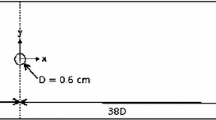Abstract
Three different large-eddy simulation investigations of the interaction between an impinging oblique shock and a supersonic turbulent boundary layer are presented. All simulations made use of the same inflow technique, specifically aimed at avoiding possible low-frequency interferences with the shock/boundary-layer interaction system. All simulations were run on relatively wide computational domains and integrated over times greater than twenty five times the period of the most commonly reported low-frequency shock-oscillation, making comparisons at both time-averaged and low-frequency-dynamic levels possible. The results confirm previous experimental results which suggested a simple linear relation between the interaction length and the oblique-shock strength if scaled using the boundary-layer thickness and wall-shear stress. All the tested cases show evidences of significant low-frequency shock motions. At the wall, energetic low-frequency pressure fluctuations are observed, mainly in the initial part of interaction.
Similar content being viewed by others
References
Beresh, S.J., Clemens, N.T., Dolling, D.S.: Relationship between upstream turbulent boundary-layer velocity fluctuations and separation shock unsteadiness. AIAA J. 40(12) (2002)
Carpenter, M.H., Nordstrom, J., Gottlieb, D.: A Stable and Conservative Interface Treatment of Arbitrary Spatial Accuracy. NASA/CR-1998-206921 (1998)
Dolling, D.S.: Fifty years of shock-wave/boundary-layer interaction research: what next? AIAA J. 39(8) (2001)
Ducros F., Ferrand V., Nicoud F., Weber C., Darracq D., Gacherieu C., Poinsot T.: Large-eddy simulation of the shock/ turbulence interaction. J. Comput. Phys. 152, 517–549 (1999)
Dupont P., Haddad C., Debiève J.F.: Space and time organization in a shock-induced separated boundary layer. J. Fluid Mech. 559, 255–277 (2006)
Dupont, P., Piponniau, S., Sidorenko, A., Debiève, J.F.: Investigation by particle image velocimetry measurements of oblique shock reflection with separation. AIAA J. 46(6) (2008)
Dussauge J.-P., Dupont P., Debiève J.-F.: Unsteadiness in shock wave boundary layer interaction with separation. Aerospace Sci. Technol. 10, 85–91 (2006)
Dussauge J.-P., Piponniau S.: Shock/boundary-layer interactions: possible sources of unsteadiness. J. Fluids Struct. 24, 1166–1175 (2008)
Ganapathisubramani B., Clemens N.T., Dolling D.S.: Effects of upstream boundary layer on the unsteadiness of shock-induced separation. J. Fluid Mech. 585, 369–394 (2007)
Garnier, E., Sagaut, P., Deville, M.: Large eddy simulation of shock/boundary-layer interaction. AIAA J. 40(10) (2002)
Hou, Y.X., Clemens, N.T., Dolling, D.S.: Wide-field PIV study of shock-induced turbulent boundary layer separation. In: 41st aerospace sciences meeting and exhibit, AIAA paper 2003–0441 (2003)
Hudy, L.M., Naguib, A.M., Humphreys, W.M. Jr.: Wall-pressure measurements beneath a separating/reattaching flow region. Phys. Fluids 15(3) (2003)
Inagaki M., Kondoh T., Nagano Y.: A mixed-time-scale SGS model with fixed model-parameters for practical LES. J. Fluids Eng. 127, 1–13 (2005)
Katzer E.: On the lengthscales of laminar shock/boundary-layer interaction. J. Fluid Mech. 206, 477–496 (1989)
Klein M., Sadiki A., Janicka J.: A digital filter based generation of inflow data for spatially developing direct numerical or large eddy simulations. J. Comput. Phys. 186, 652–665 (2003)
Loginov M.S., Adams N.A., Zheltovodov A.A.: Large-eddy simulation of shock-wave/turbulent-boundary-layer interaction. J. Fluid Mech. 565, 135–169 (2006)
Moin P., Squires K., Cabot W., Lee S.: A dynamic subgrid-scale model for compressible turbulence and scalar transport. Phys. Fluids 3(11), 2746–2757 (1991)
Pirozzoli, S., Grasso, F.: Direct numerical simulation of impinging shock wave/turbulent boundary layer interaction at M = 2.25. Phys. Fluids 18(6) (2006)
Robinet J.-Ch.: Bifurcations in shock-wave/laminar-boundary- layer interaction: global instability approach. J. Fluid Mech. 579, 85–112 (2007)
Sandham N.D., Li Q., Yee H.C.: Entropy splitting for high-order numercial simulation of compressible turbulence. J. Comput. Phys. 178, 307–322 (2002)
Sandhu, H.S., Sandham, N.D.: Boundary Conditions for Spatially Growing Compressible Shear Layers (1994). Technical Report QMW-EP-1100, Queen Mary University of London (1994)
Spalart, P.R.: Direct simulation of a turbulent boundary layer up to Reθ = 1410. J. Fluid Mech. 187 (1988)
Stewartson, K., Williams, P.G.: Self-induced Separation. In: Proceedings of the Royal Society of London. Series A, Mathematical and Physical Sciences, vol. 312. pp. 281–206 (1969)
Teramoto, S.: Large-eddy simulation of transitional boundary layer with impinging shock wave. AIAA J. 43(11) (2005)
Thompson K.W.: Time dependent boundary conditions for hyperbolic systems. J. Comput. Phys. 68(1), 1–24 (1987)
Touber, E., Sandham, N.D.: Oblique Shock Impinging on a Turbulent Boundary Layer: Low-Frequency Mechanisms. In: 38th Fluid Dynamics Conference and Exhibit, AIAA paper 2008–4170 (2008)
Touber E., Sandham N.D.: Large-eddy simulation of low-frequency unsteadiness in a turbulent shock-induced separation bubble . Theor. Comput. Fluid Dyn. 23, 79–107 (2009)
Yee H.C., Sandham N.D., Djomehri M.J.: Low-Dissipative high-order shock-capturing methods using characteristic-based filters. J. Comput. Phys. 150, 199–238 (1999)
Author information
Authors and Affiliations
Corresponding author
Additional information
Communicated by J.-P. Dussauge.
Rights and permissions
About this article
Cite this article
Touber, E., Sandham, N.D. Comparison of three large-eddy simulations of shock-induced turbulent separation bubbles. Shock Waves 19, 469–478 (2009). https://doi.org/10.1007/s00193-009-0222-x
Received:
Revised:
Accepted:
Published:
Issue Date:
DOI: https://doi.org/10.1007/s00193-009-0222-x




